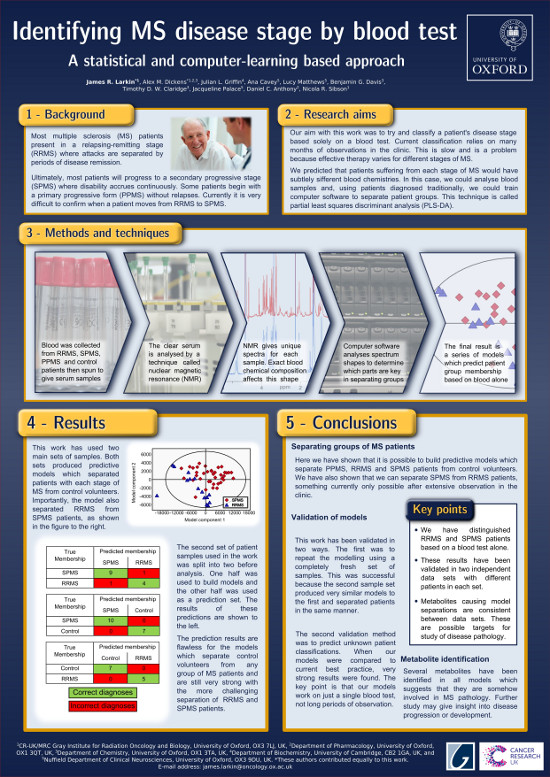Identifying multiple sclerosis stages with blood tests and computer learning
James R. Larkin, Alex M. Dickens, Julian L. Griffin, Ana Cavey, Lucy Matthews, Benjamin G. Davis, Timothy D.W. Claridge, Jacqueline Palace, Daniel C. Anthony, Nicola R. Sibson
Poster presentation and invited talk at Oxford MS Research Update Day, Oxford, UK (2013)
Abstract
Most multiple sclerosis patients begin with a relapsing-remitting stage where attacks are separated by periods of disease remission. Sometime after disease onset, patients progress to a stage where the relapses stop and disability accrues continuously; this is the secondary progressive stage. It’s important to be able to define when a patient moves from the relapsing-remitting to the secondary progressive stage as effective therapies vary. Unfortunately, this is a difficult task only achievable by monitoring in the clinic over a long period, often up to a year.
To help address this problem, we have been working on a method to classify patients based on a blood test. We collect a blood sample, then separate and remove the red blood cells leaving a clear serum sample. The serum is analysed using a technique called Nuclear Magnetic Resonance, or NMR, which uses radio waves and magnetism to produce a "spectrum" for each sample. Every spectrum has a unique shape with the exact shape determined by the chemical compounds present in the serum. We have discovered that we can use samples from secondary progressive and relapsing-remitting patients as well as healthy control volunteers to train a computer program to distinguish different disease stages. This works because the exact chemical profile of the serum from each disease group is subtly different, caused by underlying chemical changes in the blood in each patient group.
This is exciting for two reasons. Firstly, we are able to distinguish between patient groups on the basis of a blood test alone, something not possible until now. This may be useful in evaluating the outcome of clinical trials aimed at preventing disease progression. Secondly, research on the chemicals identified as changing between the two groups may allow further understanding about the biochemical basis of MS and its progression.
